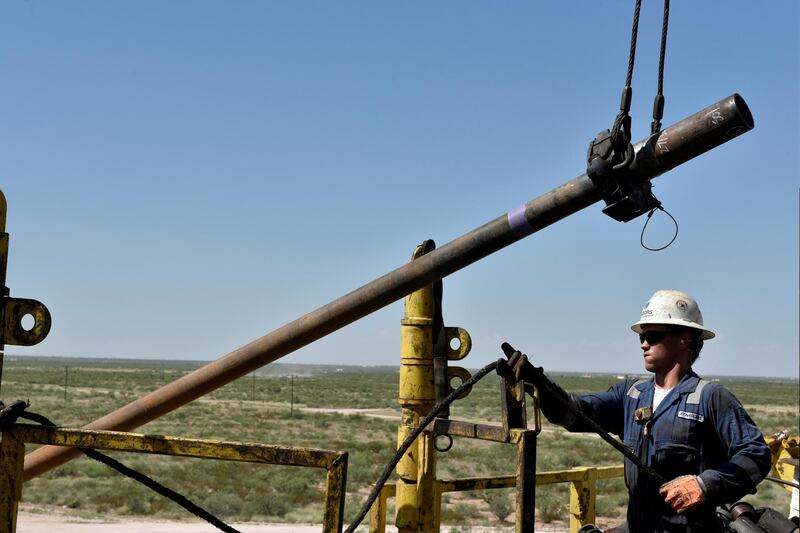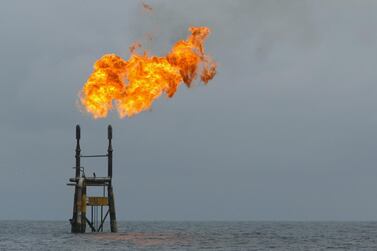Oil prices crashed to 17-year lows this month, losing 60 per cent of their value from January, when the price of Brent traded below $69 per barrel.
Although Brent crude prices jumped 4.1 per cent on Tuesday to $21.85 per barrel and West Texas Intermediate climbed 5.3 per cent by 10.59am UAE time in response to the Federal Reserve's open-ended pledge to buy as many treasury bonds and other assets as needed to ensure credit continues to flow through the economy.
Swiss bank UBS slashed its forecast for both Brent and WTI to $20 by the end of June, from previous estimates of $30 and $28, respectively. Oil producers are poised to bring on more supply, as countries hit by the coronavirus outbreak place tighter restrictions on movement.
The National explains what this bearish scenario means for importers, producers and the world economy.
Producers
The world’s major oil producers, led by Opec, wanted deeper cuts to shore up prices. However, after talks failed to extend a production cut pact with the wider Opec+ alliance, producers are now keen to in crease market share lost during the period of restriction by offering big discounts.
The expected excess supply to the market next month has lowered prices, which quickly fell from the highs of $68.91 a barrel in January to below $30 a barrel.
“With oil prices at current levels, vulnerable producer countries may see oil income plunge by up to 85 per cent,” the International Energy Agency’s Fatih Birol said on Monday.
The slump in oil prices, reminiscent of the decline witnessed in 2014-16, is expected to strain the finances of exporters relying on a steady source of oil income. Countries such as Iraq, which derives about 95 per cent of its revenue from oil, will be hardest hit. Mr Birol cautioned that for some of the poorer producers the impact could be most critically felt in the health and education sectors.
Producers such as Saudi Arabia, Russia and the UAE have sufficient oil reserves to draw on and sustain spending for a longer period.
Importers
While the low oil price environment should prove to be a bonanza for importers of the commodity, it is likely to take time before they benefit from any upside, given the travel restrictions in place as a result of the virus pandemic.
Air and ground transportation have come to a virtual standstill, denting the demand for crude. Top importers such as China and India, which also have the world’s largest populations, have limited the movements of their citizens to contain the spread of Covid-19.
India, whose gross domestic product growth was slowing before the pandemic, is expected to see GDP growth fall below 5 per cent in 2021, according to the Confederation of Indian Industry. Growth in the third quarter of 2019 slowed to 4.7 per cent, with further revisions expected for subsequent quarters, the association said.
However, with relatively low levels of infections reported, the country’s economy may yet surprise this year.
“In the current scenario, the price of oil and markets are both reacting to the slowdown in economic activity due to the coronavirus. I don’t see a specific impact of the low oil price on the Indian market at this point of time,” said Amit Bhandari, a fellow of energy and environment studies at Gateway House in Mumbai.
Global economy
Governments around the world have opened their coffers to offer stimulus packages that can support the global economy hurt by a deceleration in industrial activity and consumer demand.
The International Monetary Fund said the world needs the equivalent of 2 per cent of global GDP, or $900 billion (Dh3.3 trillion), to recover from the fallout. The hardest hit will be the international aviation sector. With flights grounded, JBC Energy estimates world traffic has slowed by 40 to 45 per cent. Jet fuel forms a critical component of global oil demand, at 3.2 million barrels per day. “Based on current trajectories [it] will get worse before it gets better,” said the consultancy.
The oil industry in the US is also expected to be hit as prices trend at two-decade low levels, with bankruptcies expected among independent shale producers. Oil majors are already slashing spending with Shell revising its capex for the year to $20bn from $25bn and suspending its share buyback. Saudi Aramco also revised its spending to $25bn from $40bn, with capex for the foreseeable future "currently under review". While the oil industry has not announced major lay offs yet, consultancy Wood Mackenzie estimates spending in the upstream sector could be cut by as much as 25 per cent this year.








